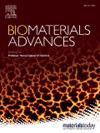负载不同氧化石墨烯含量的低镍不锈钢的物理性能及生物相容性评价研究
IF 6
2区 医学
Q2 MATERIALS SCIENCE, BIOMATERIALS
Materials Science & Engineering C-Materials for Biological Applications
Pub Date : 2025-07-13
DOI:10.1016/j.bioadv.2025.214417
引用次数: 0
摘要
机械性能和生物反应是评估外科植入物和医疗器械的关键因素。本研究考察了添加不同氧化石墨烯(GO)添加剂浓度的低镍不锈钢的结构、机械性能、氧化应激、促炎细胞因子和组织病理学结果。结果表明,氧化石墨烯含量的增加会降低材料的密度。值得注意的是,含有0.5 wt%氧化石墨烯的材料表现出优异的机械性能,包括增强的杨氏模量、剪切模量和体积模量。生物相容性通过白化病大鼠的体内研究进行评估,36只动物分为6组。无论氧化石墨烯浓度如何,氧化应激水平在两组之间没有显着差异。同样,促炎因子TNF-α和IL-6的评估也没有统计学差异(P >;0.05),除低镍不锈钢粉(S0)组外,炎症指标略有变化。除S0组出现轻度水肿外,其余各组膝关节组织病理检查均正常。这些发现表明,将氧化石墨烯掺入低镍不锈钢中可以提高其机械性能,并证实了其作为植入物和医疗器械生物安全材料的潜力。本文章由计算机程序翻译,如有差异,请以英文原文为准。

Study of the physical properties and biocompatibility assessments of low nickel stainless steel loaded with different graphene oxide content for safe biomedical applications
The mechanical properties and biological responses are critical factors in evaluating surgical implants and medical devices. This study investigates the structure, mechanical performance, oxidative stress, proinflammatory cytokines, and histopathological outcomes of low-nickel stainless steel with varying graphene oxide (GO) additive concentrations. The results revealed that increasing the GO content decreases the material's density. Notably, the material containing 0.5 wt% GO demonstrated superior mechanical properties, including enhanced Young's modulus, shear modulus, and bulk modulus. Biocompatibility was assessed through in vivo studies using albino rats, with 36 animals divided into six groups. Oxidative stress levels showed no significant differences between the groups, irrespective of the GO concentration. Similarly, the assessment of proinflammatory cytokines TNF-α and IL-6 indicated no statistically significant differences (P > 0.05), except for the group treated with low-nickel stainless steel powder (S0), which exhibited a slight variation in inflammatory markers. Histopathological examination of knee joints post-sacrifice revealed normal tissues and joints across all groups except for group S0, which showed mild edema. These findings suggest that incorporating GO into low-nickel stainless steel enhances its mechanical properties and confirms its potential as a biologically safe material for implants and medical devices.
求助全文
通过发布文献求助,成功后即可免费获取论文全文。
去求助
来源期刊
CiteScore
17.80
自引率
0.00%
发文量
501
审稿时长
27 days
期刊介绍:
Biomaterials Advances, previously known as Materials Science and Engineering: C-Materials for Biological Applications (P-ISSN: 0928-4931, E-ISSN: 1873-0191). Includes topics at the interface of the biomedical sciences and materials engineering. These topics include:
• Bioinspired and biomimetic materials for medical applications
• Materials of biological origin for medical applications
• Materials for "active" medical applications
• Self-assembling and self-healing materials for medical applications
• "Smart" (i.e., stimulus-response) materials for medical applications
• Ceramic, metallic, polymeric, and composite materials for medical applications
• Materials for in vivo sensing
• Materials for in vivo imaging
• Materials for delivery of pharmacologic agents and vaccines
• Novel approaches for characterizing and modeling materials for medical applications
Manuscripts on biological topics without a materials science component, or manuscripts on materials science without biological applications, will not be considered for publication in Materials Science and Engineering C. New submissions are first assessed for language, scope and originality (plagiarism check) and can be desk rejected before review if they need English language improvements, are out of scope or present excessive duplication with published sources.
Biomaterials Advances sits within Elsevier''s biomaterials science portfolio alongside Biomaterials, Materials Today Bio and Biomaterials and Biosystems. As part of the broader Materials Today family, Biomaterials Advances offers authors rigorous peer review, rapid decisions, and high visibility. We look forward to receiving your submissions!

 求助内容:
求助内容: 应助结果提醒方式:
应助结果提醒方式:


